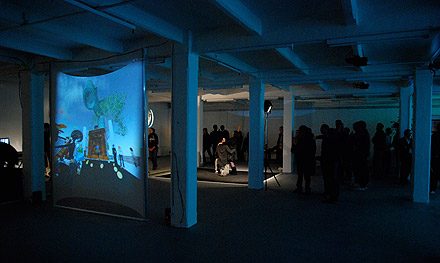 The new iMAL venue and The Gate
The new iMAL venue and The Gate
The new Brussels Interactive Media Arts Laboratory, a.k.a. iMAL opened its doors last Thursday in a gorgeous factory-style space in the heart of Belgium’s capital city. In the future it is bound to host many media art-related exhibitions as well as artists in residence and the first local Dorkbot. To celebrate the opening, Yves Bernard and his crew set up a great inaugural exhibition which also featured Buttons, so I was lucky enough to spend a night in Brussels. Here are some of the exhibited works:
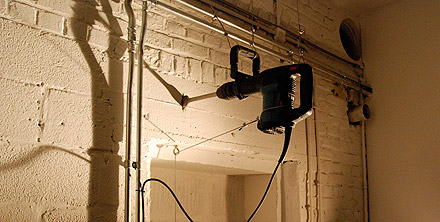 Alerting Infrastructure
Alerting Infrastructure
The first piece people noticed was probably Jonah Brucker-Cohen‘s piece Alerting Infrastructure mainly because of the pneumatic jackhammer which would make an excruciating sound every time the iMal website is accessed. The piece “is a physical hit counter that translates hits to the web site of a physical location into interior damage of the physical building that web site represents. The focus of the piece is to amplify the concern that physical spaces are slowly losing ground to their virtual counterparts.” It was suspended pretty firmly with steel wires, so it slowly disappeared into the concrete rather than punching random holes which kind of added a nice twist to it.
Sharing that space, Walter Langelaar‘s nOtbOt is “an automated game-player which is controlled and deranged by reactions to it’s own virtual environment, caught in a vicious force-feedback loop.” Basically a computer which plays itself through a modified Logitech force-feedback joystick that gets pretty violently jacked around by the feedback from the game’s graphic engine. Viewers, however, can “actually grab hold of the controller. In the process of trying to (quite literally) get a grip on the device, players confront their own metaphoric role in a feedback loop that no longer requires them”.
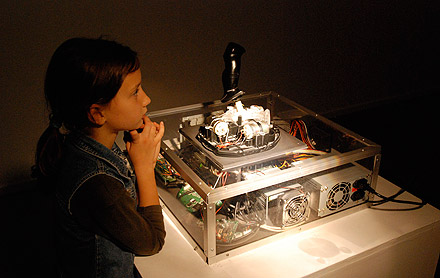 nOtbOt
nOtbOt
Antoine Schmitt brought the adjacent façade to life in his quite appropriately named project Façade Life #1. White dots bounced precisely around the windows and other structures and with minimal means succeeded in adding another two-dimensional layer to what was built from stone in 1920.
The center of the room was largely taken up by a Second Life-related piece called the gate, created by Yannick Antoine, Yves Bernard, Domenico Quaranta and the notorious SL-performance group Second Front. It worked quite literally as a portal which would stream part of the exhibition space into SL and vice versa, so people could do funky things on either side and whoever was on the other side would see it with a slight delay. For the flesh-and-blood crowd this mainly included dancing and waving, the avatars (who included Patrick Lichty of the Yes Men) were more into rezzing UPS-vans and re-enacting Rodin’s Gates of Hell on the portal.
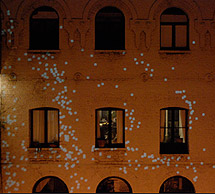
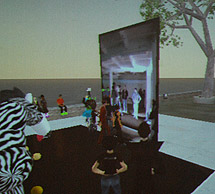 Façade Life #1 and The Gate
Façade Life #1 and The Gate
Besides Buttons, there was a nice Photography-related project called I [A]M G_7304 by Danish artist Linda Hifling. The device is a vintage “Bell and Howell slide projector with built-in monitor and sound, connecting to the online photo album Flickr”. She turns the “commodities of experiences” on Flickr “into a structuralist s(l)ideshow of the everyday”. For every 1000 uploaded photos, the projectors’ carousel turns by one frame and a computer will read the title of the photo aloud, almost turning it into a visual radio of everyday photography as shared on the site.
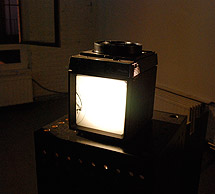
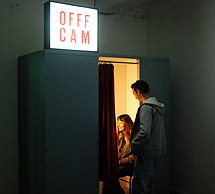 I [A]M G_7304 and OFFFCAM
I [A]M G_7304 and OFFFCAM
I missed a few pieces and especially the various performances over the last nights, but French newspaper Libération has a very good article and even a feature on nOtbOt (all in French, naturellement).
